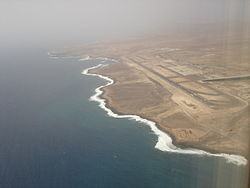Fuerteventura airport
| Aeropuerto de Fuerteventura | |
|---|---|

|
|
| Characteristics | |
| ICAO code | GCFV |
| IATA code | FUE |
| Coordinates | |
| Height above MSL | 25 m (82 ft ) |
| Transport links | |
| Distance from the city center | 5 km south of Puerto del Rosario |
| Street | FV-2 |
| Local transport |
Bus : Tiadhe Route 3, 10, 16 |
| Basic data | |
| opening | September 14, 1969 |
| operator | Aena |
| Terminals | 1 |
| Passengers | 6,118,840 (2018) |
| Air freight | 874 t (2018) |
| Flight movements |
51,541 (2018) |
| Capacity ( PAX per year) |
8.2 million |
| Start-and runway | |
| 01/19 | 3406 m × 45 m asphalt |
The airport Fuerteventura ( Spanish Aeropuerto de Fuerteventura , IATA code : FUE , ICAO code : GCFV ) is the international airport of to Spain belonging Canary Island of Fuerteventura . It is located five kilometers south of the capital Puerto del Rosario .
history
In 1940, the first work began on the construction of a military airfield in the municipality of Tefía as part of the defense plan of the archipelago. This airport was opened in January 1949 for domestic and international civilian and international air traffic. The relatively large distance of the airport to Puerto de Cabras, today's capital of the island Puerto del Rosario , and thus the most important sea port on the island, made it necessary to relocate the airport in order to cope with the increase in civil air traffic. In 1952 Tefía Airport was finally closed and Los Estancos Airport opened about five kilometers from Puerto del Rosario. The rapid increase in air traffic due to the emerging tourism forced the airport to be relocated again due to unfavorable wind conditions. On September 14, 1969, the new El Matorral airport opened on the coast in the Puerto del Rosario district. 1973 began the first direct flights with Condor from Düsseldorf. In 1978 the airport had to be expanded as the number of passengers increased significantly. Additional parking spaces and a new multi-lane road from El Matorral to Puerto del Rosario complemented the infrastructure significantly.
As of 2008: The main runway 01R / 19L (previously: 01/19) was extended by 1000 meters to the south in order to reduce the noise pollution from aircraft taking off in the capital Puerto del Rosario. The extension is not available for landings. The parallel taxiway was expanded to a second runway (01L / 19R) over a length of 2200 meters, which can be used if the main runway is not available (e.g. due to construction / renovation work). The construction work for a new pure arrival terminal with an extended apron is progressing. The new tower is ready, but not yet operational. Today's airport allows up to six million passengers to be handled annually.
Airlines and Destinations
The airport serves international flights mainly in charter traffic. Most of the flights come from the UK , Germany , Austria and the Netherlands . There are also direct connections to Ireland, Italy, Switzerland and, at times, to Poland. There are also domestic flights such as those of the airline Iberia Express , which offers flights to Madrid . The Canarian airlines Binter Canarias and Canary Fly provide the flight connections to the Canarian neighboring islands.
Traffic figures

| year | Passenger volume | Air freight ( tons ) | Flight movements |
|---|---|---|---|
| 2018 | 6,118,840 | 874 | 51,541 |
| 2017 | 6,049,291 | 947 | 48.216 |
| 2016 | 5,676,323 | 945 | 45,456 |
| 2015 | 5,027,415 | 937 | 39,307 |
| 2014 | 4,764,646 | 978 | 40,066 |
| 2013 | 4,258,069 | 1,023 | 35,500 |
| 2012 | 4,399,023 | 1,214 | 37,772 |
| 2011 | 4,948,018 | 1,558 | 44,549 |
| 2010 | 4,173,590 | 1,711 | 39,437 |
| 2009 | 3,738,492 | 1.913 | 36,429 |
| 2008 | 4,492,003 | 2,723 | 44,552 |
| 2007 | 4,629,877 | 3.127 | 44,870 |
| 2006 | 4,458,711 | 3,197 | 44,044 |
| 2005 | 4,071,875 | 3,179 | 40,415 |
| 2004 | 3,917,109 | 3,640 | 39,865 |
| 2003 | 3,919,224 | 3,695 | 39,695 |
| 2002 | 3,620,576 | 3.713 | 32,520 |
| 2001 | 3,577,638 | 3,837 | 30,471 |
| 2000 | 3,467,614 | 4,488 | 31,663 |
Web links
- Official website of the airport (German, English, Spanish)
- Official website of the operator (German, English, Spanish)
- Airport data on World Aero Data
Individual evidence
- ^ History. Aena.es , accessed December 26, 2018 .
- ↑ a b Introduction. Aena.es , accessed October 30, 2019 .
- ↑ a b c d e Estadísticas de tráfico aéreo. Aena.es , accessed October 30, 2019 (Spanish).
- ↑ Airport destinations. Aena.es , accessed October 30, 2019 .
- ↑ a b Estadísticas de tráfico aéreo. Aena.es , accessed December 26, 2018 (Spanish).

